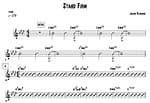Map It Out
Map It Out
In today’s post I wanted to give you a sneak peak at one of the songs that’s going to be on the album (on Mountain, Move that you can check out HERE) and talk about mapping out a plan of attack for improvisation. If you drive your vehicle from one destination to another often enough you will get familiar with how to get there and what alternate routes can be taken if there is traffic or roadblocks. The same is true for improvisation. If you’ve played the same chord progression often enough-you know how to get around. However, if you are in a new city (or have a chord progression that’s unfamiliar) you may want to map it out or have a GPS guide you.
We are going to take a look at a song called Stand Firm. The progression is not something that I think would be difficult for the vast majority of players out there. However, for our purposes we will start simple. Below is the intro and A-section to the song (from the piano part).
For me…the less I have to think about when navigating something new the better. Don’t get bogged down with too many options to start. The more familiar I become with something the more I can expand my options. When you’re driving in a new city you want to know how you get from point A to point B. You’re not too concerned on the first trip or two about alternate routes. I like to take the same approach to mapping out new chord changes.
When I map out a new chord progression I will look for commonalities between the chords. Are there key areas or centers? Can multiple chord changes share the same or similar pattern? If there are commanalities I will explore those avenues first. For instance, in the intro to Stand Firm the first two chords in the vamp are a whole step a part. So I might look for melodic device options that are a whole step a part. I could use two pairs of pentatonics that are a whole step a part. I could use chromatic targeting devices where the targets are a whole step a part (check out Targeting: Improvisation with Purpose for more info on that one). There’s a number of different ways you can use the whole step a part idea.
I like pentatonic scales because they’re simple and they are full melodic possibilities. Below is how I might map out part of the intro:
You’ll notice that above the Cmin11 chord I wrote in a few examples. The Eb and Bb major pentatonic scale as well as Cmin (which is a reminder to think in a C minor key area). Over the Dmin11 is the F and C major pentatonic (along with Emin key area reference which should be Dmin…as a trumpet player sometimes it’s hard to shut off transposing, sorry). All of those options show that I could potentially use whole step pentatonic pairs (Bb to C and Eb to F major).
I would continue this process throughout the whole progression and find what avenues would support a logical flow. Just like voice leading on chordal instruments you want to look for the closest relationships. That means finding devices that are a 1/2 step, whole step, etc. away from the other device. It doesn’t mean that’s the only way you can improvise over the changes, but it gives you a good start to get familiar with changes. Once you do get familiar, you can expand your options.
Next week we will continue to map out some more options on the intro as well as the rest of the form. Let me hear from you, though. What melodic devices/options would you use over the intro?






